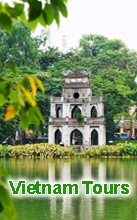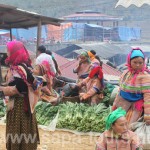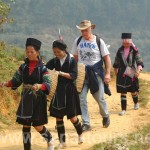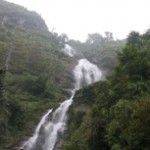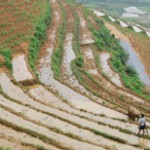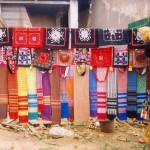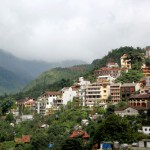Vietnam’s Sa Pa to lose its natural beauty for a tramway
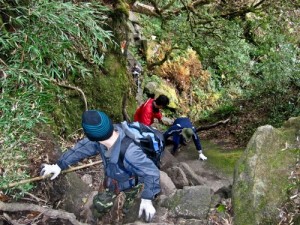 Tycoon wants to cover Sa Pa’s mountains in more concrete and metal in the form of a massive resort-entertainment-golf complex that includes a tram to the top of Fansipan
Tycoon wants to cover Sa Pa’s mountains in more concrete and metal in the form of a massive resort-entertainment-golf complex that includes a tram to the top of Fansipan
Deputy Prime Minister Hoang Trung Hai and former Party chief Le Kha Phieu attended the ceremony and issued a “groundbreaking order” for building the tramway, expected to be the “longest, highest and most complicated” aerial tramway in the world.
The tramway is part of a project called “Fansipan – Sa Pa cultural tourism, aerial tramway, entertainment and hotel complex” invested by the Sun Group. The monstrosity will also include an 18-hole golf course.
The groundbreaking ceremony was held on November 2 and after being reported widely in the media, environmentalists, smart travel companies and tourism experts have been rallying against it.
The project will be built in the Hoang Lien Son National Park, recognized as an ASEAN Heritage Park with more than 2,024 species of flora and 66 species of fauna, many of which are found only in Vietnam.
At the ceremony, Deputy Prime Minister Hoang Trung Hai hailed The Sun Group, Lao Cai authorities and relevant parties for investing in the Fansipan – Sa Pa region, which he said has “rare tourism potentials.”
He also instructed the company to “keep each grass blade and tree trunk” in place during constructing and operations, VietNamNet news website reported.
Ambitious plan
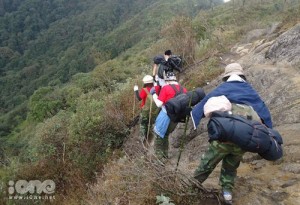 Located in the northwest highlands, Sa Pa attracts both local and international tourists alike thanks to its sub-tropical climate, untouched mountains and friendly hill tribes. It is the starting point for hikers and mountain climbers conquering Indochina’s peak of Fansipan.
Located in the northwest highlands, Sa Pa attracts both local and international tourists alike thanks to its sub-tropical climate, untouched mountains and friendly hill tribes. It is the starting point for hikers and mountain climbers conquering Indochina’s peak of Fansipan.
The tram, scheduled to be completed late next year and begin operations in 2015, will cut the 3,143-meter climb up Fansipan from two days and nights to a 15 minute “flight”.
The tramway will be the first of its kind in Asia, and the world’s longest and highest at 6,200 meters long and 3,000 meters high, Hai said at the launch of the project.
According to The Sun Group, each cable car will be able to carry up to 35 passengers and the system will able to serve up to 2,000 passengers per hour.
The company expects that Sa Pa will attract millions of tourists each year in the coming time, up from the current 960,000 tourists.
The cable car will be followed by the construction of hotels and hi-end recreational facilities in the northern highlands, including an 18-hole golf course.
The Fansipan – Sa Pa Cable Car Company, which is building the tramway, is a member of Sun Group Corporation, which invested in the 5,802-meter cable car at the Ba Na Hill Station in Da Nang, where it is based.
Lao Cai Province authorities will supervise and support the VND4.4 trillion (US$209 million) project in procedural steps.
Mistaking a concrete jungle for a forest
Dang Minh Truong, Sun Group deputy chairman and CEO, said the company is committed to preserving the natural environment and “ensuring the quality and safety of a national level project.”
However, experts are concerned that it will adversely affect the Hoang Lien Son National Park, ruining the natural beauty of the area and the challenge of conquering Indochina’s peak on foot.
Nguyen Van My, chairman of Lua Viet Tours, said the tramway will be “a disaster” for regional tourism and will threaten sustainable development.
“No one will want to conquer the peak on foot, which is the unique and common way to tour Fansipan, if there is a cable car system overhead,” he was quoted by Thoi Bao Kinh Te Saigon (Saigon Times) as saying.
“It is a mistake for the investor to want to attract tourists by introducing the most ‘modern’ and ‘biggest’ issues. Learn tourism promotion in Kinabalu, Malasia’s highest mountain,” he said.
My said only 120 tourists are allowed to visit the peak each day and they have to pass health checkups before conquering the mountain on foot. They then get a certificate for accomplishing the journey.
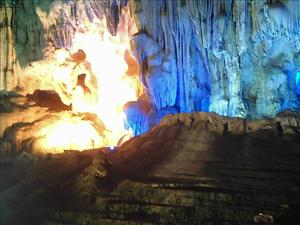 “Tourism authorities should install more road instructions and issue more maps of Fansipan instead of concretizing the natural scene here,” he said.
“Tourism authorities should install more road instructions and issue more maps of Fansipan instead of concretizing the natural scene here,” he said.
Doan Huu Duc, director of Vietnam Consulting Company, said Fansipan is a unique place and most people want to conquer the peak on foot to face the treacherous challenges.
Vu Tien Thap, deputy chairman of the 2030 Businessmen Club, said there should not be a tramway to Fansipan.
“The ‘roof of Indochina’ only has its meaning if you conquer it on foot. It makes no sense when you visit the place by cable car and get a certificate that says you ‘conquered’ Fansipan.”
Secret plan?
Bui Xuan Truong of the Vietnam National Parks and Protected Areas Association (VNPPA), said his agency was made aware of the project a few days earlier and that he was unsure if an environmental impact assessment was done before the project was approved.
Not many people were aware of the project during its preparatory stages and thus, the investor might have skipped this requirement, he said.
“If the investor did an environment impact assessment, they would have invited environmentalists and the VNPPA should have been aware of it,” he added.
In answer to questions from Vietweek, a representative from The Sun Group said an environmental impact study had been undertaken and then approved by the Ministry of Agriculture and Rural Development.
Source: Thanh Nien News
Also see:
- Sapa Việt Nam’s mountain range in top place to travel in 2019
- The Southern Fruit Festival 2017 will last for 3 months
- Cheo plays to grace Ha Noi stage every Saturday
- Vietnam among top 10 budget honeymoons: Lonely Planet
- Celebrate Lunar New Year in Sapa
- Ideal Places For Travelling By Motorbike In Vietnam
- Da Lat And Sa Pa Among Best New Destinations In Asia
- Homestay in Ta Van Village, Sapa
- Thang co’ – A traditional dish of Mong ethnic group
- Vietnam is a safe country for tourists afraid of terrorism
- Vietnam’s three destinations among top 50 most beautiful places in Asia
- Ha Giang to hold 2nd annual Mong Ethnic Cultural Festival











